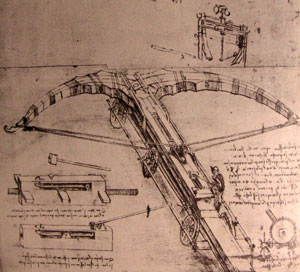|
Da Vinci’s Giant Crossbow
In 1486, Leonardo Da Vinci drew a number of sketches outlining his latest invention for combat use: the giant crossbow. His supersized version of the weapon, commonly known as a “ballista” back then, was based on a cranked-and-gear system for propelling projectiles. The device offered two possible methods for activating the firing release pin: the pull of a rope or the strike of a hammer.
 Setting Fear in the Enemy
Setting Fear in the Enemy
Leonardo da Vinci was not only a creative mover and shaker of society during his time, but also a bit of a psychoanalytical expert in the field of warfare. He possessed, perhaps better than any of his peers, a sound knowledge of the emotional impact of weapons on the human mind. He was keenly aware that their level of intimidation on the enemy could be as equally effective (if not more) than the actual degree of damage they caused.
Innovative Weaponry:
The crossbow was a popular instrument of attack in Da Vinci’s day, capable of shooting arrows more accurately than any previous military firearm, and with significantly higher penetration power. But instead of launching arrows, it is believed that Leonardo’s giant crossbow was conceived with the notion of throwing bigger, more threatening objects toward the opposing force as a mere scare tactic, such as boulders or flaming explosives. The desired outcome was to cause an outbreak of sheer panic and terror in the enemy camp, enough to bring about their retreat from the fight.
The graphic depiction of the ambitious giant crossbow shows a seemingly disproportionate soldier overseeing the enormous machine. The arms were designed to extend to approximately 24 meters in their open position, fixed atop a 23-meter long carriage, supported by 6 wheels to enhance stability while keeping the weapon mobile. In total, Leonardo’s tool of intimidation consisted of 39 invididual parts.
Crossbow Construction and Operation
As per its design, the bow section was to be built from several thin, interconnected layers of wood treated with a primitive form of lamination that would maximize the crossbow’s efficiency. First, it would allow the bow to bend sufficiently when drawing it back; secondly, it would help boost the spring tension when released. A type of cradle was integrated into the bow apparatus, so that the weapon could be armed with various kinds of ammunition.
For operation on the battlefield, the soldier in charge would begin by turning a crank on the crossbow to draw back or “cock” the bow, which operated on a worm gear mechanism, also designed by Leonardo. After arming the device, it could be fired in one of two ways. The easiest method (and perhaps the safest) involved tugging on the catch release (trigger) using a length of rope, while the other involved hammering on the trigger with a mallet.
Demise and Rebirth
By illustrating his thought processes on paper, Da Vinci could better envision his complex designs. For instance, his crossbow took on a more credible, realistic shape by means of a sketch, regardless of its improbable development. But like so many other of his elaborate endeavors, the great mechanical monster was never to be.
Nevertheless, some years ago, a massive crossbow was reproduced by a group of engineers using Da Vinci’s original sketches. The contraption required a single adjustment during its construction: the creation of a bow that was thicker and stronger than the initial one, which broke under the tremendous tension of being pulled back to full ready position.
